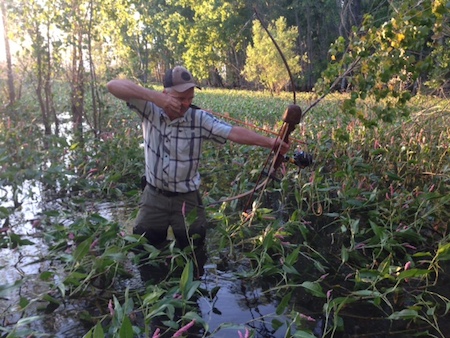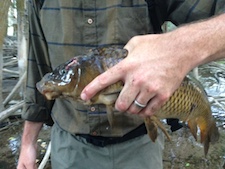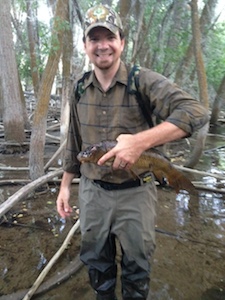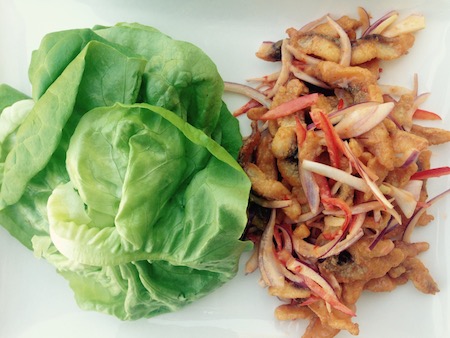The SS Money Pit is a cheap boat. It is a grand 16 feet long and has a whopping 10hp Mercury outboard strapped to the back of it. In every sense of the word it is a utilitarian boat–from the chipped green camo paint to the plywood and carpet seats. The virtues of the SS Money Pit however are endless: no need to worry about the paint, it floats, it was cheap, I can handle the repairs myself and so on. But its best virtues are just how little water it will float in and how many fish you can shoot at with a bow.
Frequently, the boat and I take journeys to the Snake River near my home in Homedale, Idaho. It is there that we will fish together–often dropping anchor and waiting for a lunker catfish. When it gets dark (and I get bored of cat fishing) the real fun starts: we break out the headlamps and spotlights and go bowfishing for carp.
 Not a native to Idaho waters, carp were introduced into the United States in the 1880s as a substitute protein resource, which turned out to be a big letdown for the U.S. Fish Commission, a precursor to the U.S. Fish and Wildlife Service. The hope was that aquaculture–specifically carp–would become as “important among the American farmers and planters as the cultivation of cattle, sheep, swine, poultry or of grains, fruits and berries.” The Fish Commission got that wrong. Aquaculture of carp is almost nonexistent in America. Even Idaho, home to a very productive aquaculture industry, does not farm carp.
Not a native to Idaho waters, carp were introduced into the United States in the 1880s as a substitute protein resource, which turned out to be a big letdown for the U.S. Fish Commission, a precursor to the U.S. Fish and Wildlife Service. The hope was that aquaculture–specifically carp–would become as “important among the American farmers and planters as the cultivation of cattle, sheep, swine, poultry or of grains, fruits and berries.” The Fish Commission got that wrong. Aquaculture of carp is almost nonexistent in America. Even Idaho, home to a very productive aquaculture industry, does not farm carp.
Like many things brought over to be farmed, they eventually escaped into the wild and are wreaking havoc on ecosystems. Inspecting a carp you see a mouth that looks like the end of a vacuum–that is because, basically,
it is. They use this vacuum to suck up eggs and plants along the banks; ruining both the fish stock and the shoreline. As such, most states have an “open season” on carp. This allows for archers to hunt them any time.
 Being a guy that does not like to kill for the sake of killing, I have eaten carp on a number of occasions. (Not all of them, usually the little ones. They taste better.) Many years ago, I even ate one while stranded on an isolated beach. They are not a bad-tasting fish, but do tend to lack in the texture department. Carp is a little soft on the bite, a typical problem for warm water fish. And the rumors that carp are full of bones are entirely true. They’re riddled with them!
Being a guy that does not like to kill for the sake of killing, I have eaten carp on a number of occasions. (Not all of them, usually the little ones. They taste better.) Many years ago, I even ate one while stranded on an isolated beach. They are not a bad-tasting fish, but do tend to lack in the texture department. Carp is a little soft on the bite, a typical problem for warm water fish. And the rumors that carp are full of bones are entirely true. They’re riddled with them!

From the front of the SS Money Pit my friends and family sling arrow after arrow, usually missing the target, but we like to follow the family motto: “aim low!” for shooting the carp. Really, I encourage every bow fisherman to take home a carp or two for dinner. You will be surprised by the quality, especially if you follow my recipe below!

Carp and Red Curry Lettuce Wraps
These little wraps will convince even the most ardent “carp are for fertilizer” bow-fisherman that culinary delight can be found with the scaly imports. Seriously, give them a try.
The Fish
- One “nice” sized carp — 18-24 inches long
- Salt and Pepper
- 1 cup flour
- ¼ cup coconut milk
- ¼ cup water
Heat 2 quarts of canola oil to 350 degrees in a small fryer or a stock pot.
Remove the fillets and skin from the carp. Check out this link for instructions on how to fillet a fish.
After the skin is removed, make sure to wash the fish. This will remove any stray scales and blood. Next, slice the fish, across the grain, into ¼ inch sections. This will seem very thin; think sushi slices thin when you cut. You will be able to feel the bones of the fish as you cut, but the high heat of the deep fryer will make the bones unnoticeable. It works–it really does!
Salt and pepper the sliced fish. Transfer the slices into the milk to wet them, then into the flour. Toss them in the flour to get an even coating. Remove the breaded slices to a single layer and reserve.
The Sauce
- ¼ cup Sweet Chili Sauce
- ¼ cup coconut milk
- 1 tablespoon red curry paste
Mix well in a small bowl.
The Vegetables
- ½ red onion, sliced thinly
- ½ red pepper, julienne cut–as thin as you can
- 1 head Boston or butter leaf lettuce
Reserve the sliced vegetables in a medium-sized bowl. Remove individual leaves from the head of lettuce. They will be the “shells” for the lettuce wraps. Keep the lettuce cold.
Finishing the Dish
In small batches, add the breaded carp to the fryer and cook for 1 ½ minutes. They will turn brown and crunchy–this is good. Remove the cooked fish to the vegetable bowl. When all the fish is cooked, toss them with the vegetables and as much sauce as you would like.
To eat them, add about a ½ cup fish/sauce/vegetable mix to a lettuce leaf — roll and eat like a taco. Add more sauce if desired.
Serve family style on large platters. Enjoy!
Editor’s Note: If you enjoy Randy’s recipes as much as I do, you will enjoy his new book even more! You can find his book, Chef in the Wild online at Amazon.com and at caxtonpress.com, and soon it will be available in Sportsmen’s Warehouse stores.







Leave A Comment